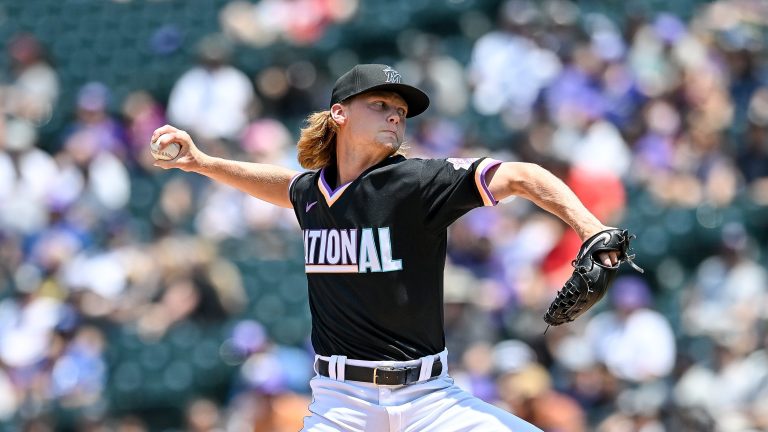Max Meyer May Have Figured It Out
A look at Max Meyer's phenomenal finish to his first professional season and why the Marlins top pitching prospect may have put it all together down the stretch.

Many were surprised, myself included, when the Marlins opted to select University of Minnesota right-hander Max Meyer with the third overall pick over Texas A&M southpaw Asa Lacy. It wasn’t that I felt one way or another about the pick, Meyer was a sure-fire early first rounder with a great track record.
What made it surprising is that it went against conventional thinking. The Marlins preferred the generously listed 6-foot right-hander from Minnesota over the well built 6-foot-4 lefty from Texas.
As philosophies have changed, the traditional scouting beliefs have been brushed aside. Lower vertical attack angles are desired for pitchers, meaning that shorter pitchers are actually preferred in many cases. The old belief that shorter starting pitchers are more susceptible to injuries has all but been debunked and in a world of high spin fastballs, a lower attack angle allows for the pitch to achieve the desired perceived rising action pitchers pursue.
Early results show that the Marlins made the right choice here, further adding to their enviable amount of high-upside arms from top-to-bottom in the organization.
Meyer impressed so much at the alternate training site in 2020 that the Marlins started the then 21-year-old in Double-A last season. Meyer didn’t blink with the aggressive assignment, striking out 28% of batters and pitching to a 2.41 ERA in 101 innings. There was plenty to like in Meyer’s 20 Double-A starts and the right-hander got better as the year went on, however in this piece I am going to focus on his two Triple-A starts, where the Marlins top prospect clued us into what is to come in 2022.
The Essential Third Pitch
The question as to whether a pitcher will develop a third pitch is one of the most common X-factors other than command. In Meyer’s case, a decent changeup is the only thing that is holding him back from frontline starter potential and after watching his last couple starts of the season, he may have found feel for the pitch.
Meyer has a big league-ready fastball/slider combination which is why we have seen the idea of the hard-throwing righty settling into a closer role floated around; he could pitch in an MLB bullpen tomorrow. The more I watch of Meyer, the more I realize how much that would sell the 22-year-old short, especially with his athleticism and ability to repeat his mechanics.
Meyer’s slider is a 70-grade pitch and is as good as any breaking ball in the Minor Leagues. Sitting in the upper 80s and even touching 90 mph, Meyer commands the pitch extremely well and held opponents to a paltry .312 OPS on the pitch. The heater sits 94-96 mph, at times hitting the upper 90s with plenty of life.
As you can see in the video above, Meyer is more than comfortable using his slider against lefties. The sharp late bite it possesses allows it to bury in on opposite-handed hitters. Meyer’s ability to locate his slider incredibly well was a big reason why he was able to dominate without a trustworthy third pitch for much of the season, but his margin for error was limited a bit. Hitters were hunting fastballs with Meyer for obvious reasons and he found himself trying to be a bit too careful.
Lauded for his command, Meyer went through a surprising stretch where he walked 18 batters in 25 innings due to him nibbling at the corners rather than trusting his fastball to get whiffs in the zone. That’s because the fastball really wasn’t performing the way many would’ve expected. Anything that wasn’t spinning, hitters felt pretty confident that it would be a heater. During that 25 inning stretch, Meyer surrendered 10 walks, 11 hits and just one strikeout on his fastball.
As Meyer gained confidence in his changeup, his fastball reaped the rewards. For a pitcher like Meyer, the changeup serves multiple purposes. The obvious is that it gives him a third speed and another pitch for hitters to have to think about. Beyond that, the offering has good arm side fade, providing an opposite movement profile of his best pitch, his slider. As a result, Meyer was even comfortable locating the changeup inside on righties who were looking for something out over the plate.
Meyer leaned on the changeup more against left-handed hitters, but to even be able to mix in the offering to righties is a testament to the pitch quality; it was always just a matter of command.
Part of what makes Meyer’s slider so dominant is his willingness to throw it in any count. Towards the end of the season, we saw Meyer mix the changeup in to either start an at-bat off or even when behind in the count. In a spot where Meyer was normally nibbling at the corners with his fastball, he was able to attack with a changeup.
The psychology of an at-bat against Meyer is exponentially more daunting when he starts you off with a changeup. Does he go to it again? Does he then bump it up 10 mph with his 96 mph fastball, or does he spin you the plus plus slider?
Those questions are much more stressful for a hitter to sort out rather than hunt fastball and dare Meyer to locate three sliders. Confidence in the changeup brought along confidence in the fastball and as a result, Meyer struck out 24 batters and walked just two in his final three starts.
2022 Outlook and Beyond
There’s no reason to believe Meyer’s changeup development at season’s end was a flash in the pan. After all, if this Marlins organization is good at one thing, it is developing changeups. Trevor Rogers, Sandy Alcantara, and Pablo Lopez have seen their changeups dramatically improve as they have developed, largely contributing to the trio’s success. The same could be said of Edward Cabrera in his Minor League dominance.
The Marlins rotation is currently loaded with the aforementioned four arms as well as electric southpaw Jesus Luzardo–who we recently sat down with to talk about his 2022 outlook–as well as former top prospect Sixto Sanchez on the mend and Elieser Hernandez.
For Meyer, all he can worry about is continuing to pitch and letting the rest take care of itself. Having only made two Triple-A starts and needing to build on the progress he made with his arsenal, I’d expect Meyer to start in Jacksonville next season with a chance at a June call up. The Marlins are reportedly looking to trade from some of their pitching in order to acquire more bats, and Meyer is probably one of the last names they’d want to part with.
If Cabrera or Luzardo struggle, Meyer should get a crack prior to the All-Star Break. A trade or injury could also open up a rotation spot for Meyer at some point as well. In terms of Meyer’s ceiling, he is our No. 34 prospect in baseball for good reason, he has frontline potential. Meyer’s athleticism, overall strong command and potentially elite three-pitch mix give him a chance to become an ace with a high-end floor of either a No. 3 starter or lights out closer.
After watching more of Meyer, I’d consider the closer outcome as an absolute worst-case scenario. The 22-year-old right-hander has all the goods to be an anchor in an already loaded Marlins rotation for a long time.

